
Gemalto's Solution for Government

Click Here to jump to pricing!
Overview:
We help governments, national printers and integrators design and roll-out secure documents and robust digital identity solutions.
Beyond the traditional enrollment, personalization and issuance services, our eGovernment infrastructure and innovative applications will help win citizen's acceptance and boost usage. A leader in digital identity solutions, we are active in over 100 government programs worldwide.
The success of YOUR project
Gemalto's experience, solutions and resource are key assets for the success of your project:
- Leverage best practices with Gemalto, drawing on our involvement in over 30 electronic passport programs, more than 40 national ID initiatives, 20 citizen and voter registration programs, numerous driver's license, health and social schemes worldwide
- Mobilize our experienced service teams and established network of partners to support your program
And every step of the way, Gemalto will do more than simply listen and make sure that the solution is shaped precisely to your unique requirements.
Why not base your program on tactics that are already proven to work? Learn more from our best case studies below.
Our Solutions
- Security Features
- Travel Document
- National IDs
- Driving Licenses
- Border & Visa Management
- Healthcare
- Mobile ID
- National Register
- Enrollment
- Issuance
- Document Verification
- Voter Authentication
- eGov
- mGov
- Professional Services
Identity:
National ID card and eID programs
Improving security, slashing ID fraud and identity theft and creating an infrastructure of trust for new on-line access are high on every government's agenda, with a call for greater security features and the necessary legislation to implement them.
Secure national ID cards
Many countries are now upgrading their national documents and rolling out government issued IDs in the form of a credit card.
These new documents are including high security printing features to deter fraud.
In addition, these national ID programs are also the opportunity to create a secure digital identity for each card holder. These secure electronic identity cards, generally referred to as eID cards or simply eID's are opening the gate to secure and trusted on-line services.
The most common applications for these smart cards are in smart travel documents, electronic ID's, electronic signatures, municipal cards, key cards used to access secure areas or business infrastructures, social security cards, etc.
Many advanced countries are now demonstrating that, beyond the security benefits for both states and individuals, ID cards with their derived digital IDs can provide citizens and businesses with real services and benefits, without infringing upon new rules on data protection and civil liberties.
As the leading provider of secure, tailor-made ID solutions, Gemalto can help governments improve security and deploy electronic applications to offer better public services and cut administration costs.
Our expertise in numerous government ids around the world can also help accelerate the dynamics of your national digital framework of trust.
Gemalto's eID card solutions increase citizen protection, contribute to better control immigration and offer an effective means of ID checking, using security that is always one step ahead. Gemalto offers a variety of secure eID cards with a range of professional solutions for a complete solution, which can be delivered as individual systems or using a managed service option.
Gemalto is contributing to 40 national eID programs: in Europe (Belgium, Czech Republic, Estonia, Italy, Finland, Norway, Sweden, Portugal, Lithuania, Luxembourg), in the Middle East (Jordan, Qatar, Oman, UAE, Bahrain and Saudi Arabia), in Africa (Algeria, Cameroon, Nigeria, South Africa), and in other areas.
Residence Permits
Sealys eResidence Permit by Gemalto offers the most complete, versatile electronic European Residence Permit (eERP) solution tailored to customer needs.
Sealys eResidence Permit enables governments to realize significant cost savings and reduce fraud and illegal immigration.
Gemalto has supplied Sealys Residence Permit solutions to numerous countries, including the first generation of chipless products and now the second generation smart card based solutions.
Multi-application national ID cards
Sealys MultiApp ID is a Global Platform smart card solution for eID, eDriving License, eRegistration Certificate and eHealthcare. It is a Public Key Java Card designed to meet the most advanced security requirements of long-term multi-application programs such as the ones launched by governments and health insurances. Sealys MultiApp ID supports RSA up to 4096 bits and Elliptic Curves up to 521 bits in particular and has been Common Criteria EAL 5+ certified.
Sealys MultiApp is the leading secure, open and standard-compliant operating platform for electronic document issuance. It supports a wide range of identity applications serving the deployment of a raft of citizen-centric government programs.
An innovative turnkey solution to federate eID programs
With contributions to more than 100 eGovernment programs to date, Gemalto has played a front-line role in making the new paradigm of secure multi-service electronic ID cards a reality. Drawing on its extensive experience, the company has devised an innovative turnkey solution to federate eID programs across multiple government agencies, bringing together the best of smart card technology, software solutions and multi-service apps.
Digital identity trends – 5 forces that are shaping 2017

Digital ID is well and truly established as one of the most significant technology trends on the planet.
Indeed, for a growing number of public stakeholders and citizens, it's already a day-to-day reality. As a result, a revolution in the way that individuals interact with public institutions is underway. And the private sector is fast getting in on the act too.
In this dossier, we'll highlight the five key digital identity trends that are set to shape the landscape in 2017.
But first, let's look back at some of the landmarks of 2016.
Digital ID milestones for 2016
Before we look to the future, let's review the big ideas that gained traction in 2016. This will provide some reliable indicators as to where we are heading in 2017 - and beyond.
National ID schemes increased in number, visibility and reach
- The UN and World Bank ID4D initiatives set a goal of providing everyone on the planet with a legal ID by 2030.
- Numerous new national eID programs (including card and/or mobile-based schemes) were launched or initiated. Examples include new schemes in Algeria, Cameroon, Jordan, Italy, Senegal and Thailand, major announcements in the Netherlands, Bulgaria, Norway, Liberia, Poland, Jamaica and Sri Lanka, and a pilot scheme in Myanmar. Most of these programs now include biometrics, the majority in the form of fingerprints.
- Schemes such as the Gov.UK Verify initiative were also introduced in 2016, and Australia announced that the first phase of its digital identity program will be launched by August 2017.
New technologies and regulations emerged, supporting and shaping the digital transformation ahead
- Digital driver's license projects (also known as mobile driver's licenses) gathered momentum in countries including the USA, UK, Australia and the Netherlands.
- Early tests of blockchain technologies took place: in Estonia, to aid development of a ground-breaking transnational e-residency program; in the UK, to see how it can be used to help make efficient welfare payments to citizens.
- Smart borders/smart airports emerged at a faster pace. Combined with the 700 million plus ePassports now in circulation, and a strong push behind biometrics (particularly face recognition), they offered travelers a taste of cross-border movement that is as secure as it is swift and seamless.
- The European Union's Electronic Identification and Signature (eIDAS) regulation came into force in July 2016, requiring mandatory cross border recognition of eID by September 2018.
New standards emerged, fostering compatibility and interoperability
- A new ICAO working group on digital travel credentials was created, led by Australia.
- The LDS2 conception phase – 'the future of the ePassport' - was undertaken by the ICAO NTWG Logical Data Structure 2 Sub-Group.
- The ISO SC17 WG10 - Task Force 14 "Mobile Driving Licence" started to work on verification standards for Mobile DL and defined the scope of off-line verification. 2017 will see draft specs of both off-line and on-line verification appear for a new work item.
- The IATA mobile ID working group was constituted in 2016, and is starting in 2017.
- The US Commerce Department's National Institute of Standards and Technology (NIST) awarded a federal grant to further support development of trusted identities, based on the Digital driver's license.

5 forces that shape 2017
What's on the way in 2017?
To start with, don't expect any slow down in the momentum we've experienced over the last year.
2017 will see some of the most accelerated evolutionary changes experienced so far by public stakeholders and their partners in the field of secure digital identity.
In particular, we think that these changes represent essential considerations for authorities that want to make digital identity and on-line services (particularly mobile services) defining features of their modernization processes in the years to come.
We expect to see:
- More mobility
- Greater demand for security and trust
- An accelerating shift towards smart cities
- More calls for public supervision of digital identification systems
- Even more National ID card and eID programs, national ID initiatives and implementations
Now it's time to consider each of these in more detail.
#1 Mobile communication dominates
ID will become ever more mobile in 2017. Of course it doesn't take an expert to recognize we've entered an era in which mobile connectivity dominates. But it's worth emphasizing that the trend shows no sign of abating. And the implications for digital ID are profound.
Look at some of the facts:
- 75% of internet use in 2017 will be mobile according to Zenith's new Mobile Forecast report
- Google – a company that knows a thing or two about the future of technology - is steadily moving towards a mobile-only world.
The lesson for all digital ID stakeholders is clear: prepare for mobile-first solutions.
#2 Guaranteed security: Private data, public framework
We'll expect nothing less in 2017. Identity is the link that connects an individual to his or her community. For public authorities, the key challenge in 2017 will be to create harmonious digital bonds that secure the relationship between new mobile identities and wider society.
This is only possible through a public framework of trust, built on guarantees of private data protection and security.
Contrary to what the media sometimes suggests, in 2017 we'll see once again that measures taken to bolster security and combat fraud are generally well accepted by citizens. These are, of course, sovereign matters par excellence.
These predictions are confirmed by what we discovered about expectations for mobile security, in interviews conducted with 1300 citizens in November 2016.
Further support is provided by O2, one of the UK's leading mobile communications companies, which confidently predicts that "security will have the final word in all things mobile in 2017."
In 2017, robust security measures will be the obvious response to new demands for trust in all exchanges between citizens and public authorities.
Take a look at these key takeaways:
- Citizens are prepared, willing and waiting for greater security.
- 2017 represents a perfect opportunity for public authorities to revitalize the 'sovereign bond' with citizens. In doing so, they can prove it is not some obscure relic of the past, but a symbolic, identity-rich vehicle for collective trust.
#3 The smart city will become our playground
Around the world, the shift of populations to urban environments is already one of the defining trends of the 21st century. Inevitably, technological developments are becoming inextricably linked with this mass migration. The digital or smart city is becoming the model that ensures consistency in all the links between urbanites, their wider communities and public authorities. This includes, of course, eGoverment and/or mGovernment, within which digital identity is the key that unlocks the individual's access to a rich array of services and support.
Or, to put it another way, the smart city is set to become our new playground.
By their very nature, smart cities are mobile environments. Digital ID will therefore represent the 'virtual umbilical cord' that continuously links each individual to their public and social life.
In 2017, the message for public authorities is clear: national digital ID creates an unrivalled opportunity for local creativity.
So here's another key takeaway
- Think national, act local. In a mobile-only world, local services become even more relevant.

#4 Public supervision will be critical to sustain growth in the digital economy
Faced with an increasingly challenging economic landscape, governments are inevitably searching for new opportunities for sustainable, harmonious growth.
As regulatory environments take shape, close collaboration between the financial world, central and local public authorities and digital communications operators will support effective solutions and implementation of best practices.
Of course, the real source of new business opportunities is not digital identity itself, but the myriad of applications it enables. This is where banks and other operators will see a bottom line return on their investment.
As already outlined, the march of digital ID is well underway. In 2017, the focus will therefore be on the adoption of the new structures and regulations that are needed to govern the associated services and transactions.
So what does this mean in practice?
The role of public authorities in 2017 will be to:
- Build and nurture national momentum.
- Support and coordinate local government investments through which local transformations, close to the community, can operate effectively and efficiently.
- Make sure that these multiple local initiatives create a coherent and interoperable spectrum of solutions: wherever they may be, mobile citizens will need to find similar modes of service.
In the year ahead, the market will follow these initiatives.
How can we be so sure?
Because evidence of uptake of digital ID and associated services is multiplying. Giving us the clearest signals since the concept was first introduced some fifteen years ago that a tipping point has been reached.
#5 Three-stage dynamics will drive pilots and roll-outs
The digital ID evolution – as broad as it is dynamic - will continue to move forward. The citizen is the fundamental driver of these changes.
Millennials now make up a majority of employees and a growing proportion of total citizen populations. They are reshaping the culture of our institutions. Ultimately, this tech-savvy generation is being proved right. The older generations, by finally joining in and adopting these forms of technology, can break out of their isolation, stay in contact, and preserve social and especially family bonds.
For 2017, we see equally strong dynamics across the following three stages:
- From theory to proof-of-concept: 2017 will be the year of proof-of-concept for the blockchain in public services - specifically in areas such as e-government and health care. Questions are still open on the real interest of this technology for digital identity.
- From proof-of-concept to pilot: As it moves from a proof-of-concept technology into secure and interoperable solutions with new standards, 2017 will be the "year of the pilot" for digital driver's licenses, digital credentials on mobile, and virtual/digital and cloud passports.
- From pilot to implementation: Countries will move more quickly than expected, and we could reach a tipping point over the next 12 months. Many national ID schemes are approaching critical mass.
Now it's your turn
2017 holds many changes in store. Certainly we can't claim to predict all the important issues and topics that will emerge in the year to come. Can you fill in some of the gaps?
If you've something to say on 2017, a question to ask, or have simply found this article useful, please leave a comment in the box below. We'd also welcome any suggestions on how it could be improved, or proposals for future articles.
National IDs: 2016 facts and trends
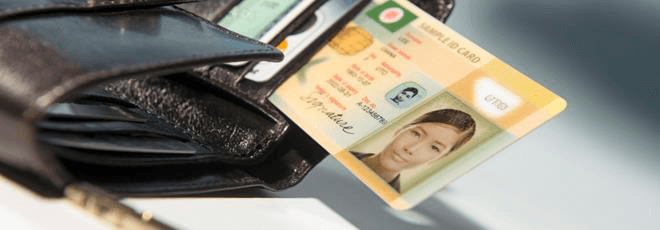
The past ten years have brought a sea-change in what citizens and governments expect national IDs to deliver. This period has also been filled with incremental tech developments that are serving as a foundation for a much smarter citizen ID future.
Biometrics, electronic ID cards, mobile IDs, virtual documents such as "mobile" driver's license and the need to set up a national identity framework have moved to the main stage in 2016.
Biometric IDs are here
Fast forward to 2016 and digital identity technologies such as smart cards and biometrics have come of age, with an estimated 120 countries now deploying electronic passports incorporating these highly secure features and over 50 countries implementing eID cards.
National ID cards have undergone a huge transformation; simple paper documents designed for single identification applications have given way to smarter documents in the form of a credit-card. These citizen ID cards or eIDs include a microprocessor for stronger document verification but also on-line authentication and signature. As they contain the portrait of the card holder and very often fingerprints, they can be used for biometric identification and biometric authentication when needed. This new generation of national identification card offers one of the best identity theft protection. These eID cards also enable governments to implement on-line applications such as eGovernment solutions giving citizens access to public services with the reassurance of robust security. The development of these government issued IDs means a single card can offer a host of applications – from acting as a driver's license, enabling the user to file their taxes or giving him/her access to state benefits.
3.5 billion citizens to carry a national eID by 2018
But while some nations have been reticent in adopting eIDs, other countries have been far more bullish.
We've seen implementations in Asia with China, Malaysia and Indonesia to name a few, or across Africa with countries like the Republic of South Africa, Nigeria and more recently in 2016 with Algeria.
Added to that are deployments across large parts of Europe, in the Gulf and in parts of Latin America. All provide interesting examples of the potential of eIDs to affect millions of ordinary lives throughout developed and emerging economies.
According to research company Acuity Market Intelligence (2014), the number of electronic National IDs in circulation will reach 3.5 billion citizens by 2018 – by which time, the number of countries issuing National eIDs will overtake those issuing traditional National IDs by a ratio of more than 5 to 1.

From eID to KYC and economic empowerment
The case for eID cards and ePassports is quite straightforward for most people in the eID industry. In the business world, they play a key role in enabling financial services firms and telecoms companies to fulfil Know Your Customer (KYC) requirements and carry out Know Your Employee checks. They allow government departments to interact with their citizens more effectively around the clock.
In the border control environment, combined with facial recognition and biometric authentication systems, they boost security and improve passenger throughput, giving authorities the confidence that the person standing in front of them is who he or she claims to be.
Emerging economies see the value of eID credentials in general, because they promote economic empowerment, drive democracy and aid economic development as highlighted by the World Bank Group initiative named ID4D . They show the rest of the world that they are modern, secure and trustworthy states, able to implement new technologies and standards – and very much open for business. Furthermore, secure ID technology that can be used cross-border is important as it promotes regional integration and stability and makes economic development more likely.
Mobile ID – digital identity at work
Over recent years, mobile identity (mID) has proved an increasingly popular choice with citizens, thanks to its convenience, ergonomics and high level of security. The rapid adoption of m-Government services in countries that have chosen to focus on mobile communication devices, has demonstrated the appeal of this strong and trusted method of identification.
Some visionary countries have made the leap to mobile ID or mID, through the creation of a mechanism using an eID component for accessing online services via mobile devices. Pioneers include countries where market penetration of cell phones and new technology is strong such as Austria, Estonia, Finland, Norway and Turkey. Mobile ID projects are sometimes driven by the need for a universal form of identification (Austria 2003), or, in the case of Estonia in 2007, to supplement a national card program and accelerate the development of electronic identity and digital signature. In 2014, Oman was the first country in the Middle East to complement its national electronic ID card with a mobile ID scheme. As a highly trusted channel between citizens and service providers, mobile ID continues to extend its use from egovernment into other online areas such as banking and payment.
"1984" did not happen
Contrary to the vision of novelist George Orwell in '1984', national eID schemes have shown that managing citizen IDs can protect civil liberties, identity and social interactions in a state of law.
Electronic records on individual citizens are available upon request of their owner in many European countries with a national eID scheme. As President of Estonia Toomas Hendrik Ilves puts it: "You own your own data, so you have the right to access it any time." When introducing its national eID in Belgium, the government offered citizens an application enabling them to know who has accessed their personal data. And of course the key to accessing this online app is the national eID card. Each citizen can consult their personal file in the national data register to see a record of when government officials have accessed their personal data and for what reason. It's a good example of how transparency and traceability in every transaction between governments and their citizens can help protect privacy and strengthen trust.
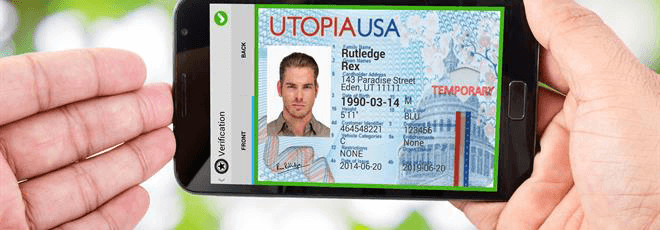
On the road to the virtual driver's license
So when will we have a digital driver's license on our mobile phone?
Today you can already do a lot with a smartphone. And the trend for on-phone payment, loyalty or travel applications may yet bring the driver's license to your mobile. While a driver's license primarily confirms identity and driving rights, a virtual driver's license also called mobile driver's license or digital driver's license potentially brings many more benefits and opportunities for issuers, regulatory authorities and particularly drivers.
The traditional driver's license is an important proof of ID (identity and age) checked by enforcement agencies, retailers and financial institutions alike. A mobile driver's license would provide an on-screen version of the traditional photo and driver information, and more. As a highly secure mobile application, it has stronger counterfeiting characteristics, enables driver data to be updated instantly and facilitates real-time communication opening the way to new business models using a trusted and secure channel. Several US states have launched pilots to explore the user convenience, privacy and security and interoperability of mobile driver licenses.
Though the mobile driver's license still has some distance to travel before becoming a complement or replacement to the plastic license we're used to, there's clearly an interest with other countries like Australia and India also looking into this option.
From eID to national identity schemes
Digital identity management is at the heart of the Internet economy as a key enabler for trust and innovation. Many countries are now putting in place the framework of their national identity scheme. This helps define the roles of the state, for example as regulator or issuer of digital identities (or neither), responsibilities in organizing data, applications and infrastructure and the underlying principles and operating methods of the digital identity ecosystem such as a federated identity management infrastructure. This can cover everything from how digital identities are used to authenticate users, or verify data linked to the services and detail the identity types and levels of trust within the scheme.
Currently, different approaches are being pursued – from a state-led role in issuing digital identities and structuring services, as seen in Estonia or the United Arab Emirates, to the more decentralized system in Germany, or an identity ecosystem developed through a partnership between public and private sectors as is the case in Sweden.
Certain nations largely delegate the provision of identity solutions to the market, and therefore the private sector: this is the case in the United Kingdom who said no to a UK ID card as such.
In the US, National Strategy for Trusted Identities in Cyberspace is similarly exploring a more global system of interoperable identity service providers (public and private), giving individuals the choice of secure credential/s using a variety of options from mobile phones to smart cards and computers.

5 Reasons for Electronic National ID Cards:
Over recent years, electronic national ID cards (aka eID cards) have been introduced in numerous countries around the world. Furthermore, they are being utilized with ever-growing enthusiasm by their citizens.
But in countries yet to adopt such microprocessor-based smart card technology, serious concerns are still voiced. Common criticisms of eID schemes include the potential threat posed to civil rights and privacy, a lack of confidence in the reliability and safety of such systems, and a belief that they are quite simply unnecessary and irrelevant.
However, a measured assessment of the many successful national eID deployments that are now up and running provides five clear and compelling responses to these and other fears.
So, what are the benefits of national identity cards?

#1: National id's : security and protection for citizens' data in a digital world
In the past decade, the number of digital exchanges has increased exponentially. But obvious attractions of ease of use go hand-in-hand with the widely held perception that electronic media is relatively fragile.
The absence of traditional "written proof" and eye witnesses, which are characteristic of electronic means of exchange, has very quickly led to the need for a solution that can guarantee the identity of the issuer or the receiver.
Since 1997, the design, production and deployment of secure national electronic ID cards have sought to meet just such a requirement. As a result, the idea of an ID card that is valid for both the physical and digital domains has become a reality for millions of people.
Some visionary countries have also made the leap to mobile identity or m-ID, meaning the creation of a mechanism - initiated using the national eID component - for accessing online services with a high level of security thanks to mobile devices as detailed in our December 2014 white paper on our national mobile ID schemes.
Today, more than 60 countries have set up a national ID scheme and most of them are issuing electronic national ID cards.
What's more, the electronic format of such cards means that, in addition to being employed for electronic signature applications, they are also ideally suited to other use cases as detailed in 2016 ID trends published in May 2016.
Typically these can include granting the user access to company infrastructures or secure locations, as well as incorporating social security cards and, in some countries, drivers licenses, healthcare cards, "pass cards" for transport services, payment cards and even bank cards.
So why are so many countries relying on smart eID technologies?
#2: The technology used is robust and fit for purpose
Using 'smart' banking cards, billions of dollars are sent around the world every day without being stolen.
The very same technology can be used to address the growing threat of identity fraud.

The microprocessor-based smart card (and SIM card in your mobile phone) protecting identity credentials is considered the most secure means of authentication. It makes it possible to prevent identity fraud and effectively protect citizens' personal data. That's why it is established as the media of choice for granting access to e-Government applications.
This approach can also be used to host a range of other services and use cases, such as e-payments, e-purses, digital signatures, authentication, identification and travel cards.
It should also be noted that this technology now protects travel documents, commonly known as electronic passports, in close to 120 countries, dating back as far as 2006.
#3: A national ID card scheme can lead to greater transparency
One example of a national ID scheme that empowers citizens is provided by Belgium's eID project.
The law which accompanied the introduction of the new eID card in Belgium required the government to offer citizens a "My File" application, which can be accessed online. This allows people to know who has accessed their personal data. A query or complaints form is made available to citizens, who can also request that the government provides a justification for any recorded access. Similar rights apply in several other European electronic ID schemes.
A fundamental democratic principle is observed: when a new constraint is introduced (in this case, digital footprints), a new right is provided (transparency). A record is kept each time Belgium's National Register data is accessed by a government official, noting the identity and place of work of the official who accessed the personal data of a citizen, and the date it took place. In the six months following access, the citizen can consult their personal databases to view this information.

#4: "1984" did not happen
The fear that an ID card system represents the start of a slippery slope to greater surveillance and monitoring of citizens has proved unfounded.
Quite simply, the oppressive scenario described by George Orwell in his novel "1984" did not happen.
A national ID scheme is not synonymous with totalitarian governments wielding absolute power.
The reality is that "1984" did not come true in Austria, Finland, Italy, Sweden, Spain, Germany, Belgium, the Netherlands, Luxembourg, Estonia, Lithuania, Malaysia, South Africa, Uruguay or Chile – to name just some of the 50 countries that have so far moved to eID.
And remember: an eID card will always remain where you want it - in your pocket or mobile phone. You alone decide if and when you want to use it.
But you may be thinking: “OK, I get all that. But HOW do we actually do it?”
Let’s dig in.
#5: National ID system : Building the chain of trust
The issue of legal continuity is at the heart of the digital transformation of our exchanges and transactions. Whatever the media, digital exchanges should enjoy the same legal security as their physical equivalents.
Governments worldwide are seeking to boost efficiency, economic development and inclusion with the ultimate aim of better serving their citizens in a reliable, secure and transparent way.
National identity schemes
They deploy national identity trust systems not only to rationalize services and processes in areas such as social services, taxes, local voting and administration, but also to promote private services by stimulating the digital economy, all while reducing costs. They can reap the digital dividends quite effectivdely as evidenced by our August 2016 web dossier and The World Bank's May 2016 report.
Gemalto believes that modern digital economies are built on the implementation of reliable digital identities for citizens. Only this can ensure the necessary level of trust in the internet and the mobile devices of the future, with interoperable authentication and signature solutions, through the implementation of secure portable devices ("secure elements"), such as PKI (Public Key Infrastructure) SIM cards, identity cards, as well as many other innovative devices.
Our worldwide experience has shown that the implementation of secure trusted eID is essential for the unreserved and enthusiastic adoption of eGov solutions by citizens. They are the ones who must carry this physical object on their person – a digital safe containing their identity, personal data and rights – enabling strong authentication through at least two factors: "what I have" (my secure mobile device) and "what I know" (my confidential code).
Overall, the key message for those with concerns over electronic national ID schemes is that security and surveillance are not one and the same.

What is security in the digital age?
Security provides us with the power to be more creative in promoting our well-being - whilst also limiting the effects of uncertainty, as best we can. Security is not something that constrains, limits or restricts us. Instead, it is the very thing that opens up new possibilities; providing the reassurance we need to take full advantage of the benefits of human development, acting within - and protected by - the rule of law.
With stronger reassurance and improved security, we can do more, and in a more effective way, to bring about the changes which will shape our future.
Gemalto's business is focused on digital identity and security. As well as defining a corporate mission, our company slogan - "Security to be free" – echoes the values that are at the heart of any sustainable digital society.
ID-Motion:
National identity card system : adaptive solutions with Sealys ID Motion

Independence and security for national ID projects
Crafting a national ID system is no easy task.
Government programs can encounter significant delays when interoperability is attempted in more ambitious ID document projects.
Indeed, when card deployment is predicated on it, the time required to reach technical consensus is often underestimated.
And you know that rushing this process can result in an end-product that fails to address the specific needs of all parties concerned.
In other words...
...a fragmented approach is inneffective and can even lead to situations where agencies work against each other rather than with each other.
ID Motion is a complete eID management structure to rise to the challenges of pooling the new secure identity documents and their infrastructures to create a future-proof national identity card system.
In particular, this range of cards, solutions and services meets the issuing bodies' need for independence, their security requirements, and provides the flexibility required to cater for applications deployed after the initial launch.
ID Motion provides the advanced post-issuance capabilities necessary to orchestrate the creation of a coherent and adaptive national identity system.
Breaking down the barrier of fragmented infrastructures
Fragmented infrastructures with several different ID documents do not lend themselves, in the long-term, to the creation of a national infrastructure of trust able to support the requirements of digital ID, an essential tool for a national ID system and key to the modernization and digital development of a country.
With ID motion, you can:
- pool enrolment, issuance and post-issuance facilities
- implement a true multi-application single platform
- bring the right answer to scalability and adaptability with secure post-issuance features.
Building a national ID system across government agencies
Sealys ID Motion delivers on the promise of building an infrastructure for trust in eID schemes across government agencies.
By eliminating technological and operational barriers, it enables overall security to be strengthened.
Higher security levels will then become more accessible to ID programs, opening the door to enhanced privacy for the citizens using public services.
This enhanced privacy and security will also protect public investments and benefit new stakeholders, such as :
- local authorities
- municipalities
- private sector vendors
Security: we mean it and set the new standard
In April 2013, ID Motion smart card has obtained the highest possible level of internationally recognized security assurance. As the first smart card operating system in the world to achieve the exacting EAL7 Common Criteria certification
ID Motion quite simply sets a new standard in the market, and is a clear illustration of Gemalto's commitment to providing ever-more secure solutions for governments and citizens alike.
By design, it also ensures full confidentiality between interacting parties, enabling the fullest protection of citizen privacy.
How can we help you create your national identity system?
With contributions to more than 100 eGovernment programs to date, Gemalto has played a front-line role in making the new paradigm of secure multi-service electronic ID cards a reality.
Drawing on its extensive experience, the company has devised ID Motion, an innovative turnkey solution to federate eID programs across multiple government agencies, bringing together the best of smart card technology, software solutions and multi-service apps.
Travel Document:
ePassport solutions: your epassport migration is now
Electronic Passport components and solutions for government printing works
End-to-end ePassport solution
Gemalto offers a complete end-to-end ePassport solution.
From issuance and personalization of highly secure travel documents such as biometric passports to enrolment and strong border control security solutions, Gemalto can offer the whole product or supply any part of the chain. We deliver fully compliant, highly secure, tailor-made solutions in your hand, when you want it, safe, secure and trusted.
Components and solutions
Gemalto also offers a wide range of components and solutions for National Printers that are issuing machine readable passports, electronic passports or the latest generation of biometric passports.
Our core offer is Sealys eTravel, our ICAO compliant secure embedded software, which offers the highest level of performance and interoperability in the market.
Sealys Premium Inlay and Sealys premium eCover are our ultra-thin and flexible inlays and electronic covers for easy integration in booklet manufacturing process along with the support from our experts and technical consultants for optimal results.
For security conscious printers, we offer polycarbonate datapages, for the highest level of security and the use of innovative security features combining optical and visual features.
We offer the innovation of secure Color picture in polycarbonate with no compromise on security and durability.
Sealys ePassport components sustain the real-world stress of stringent day-to-day use and thus have a long lifetime up to 10 years in the field. This is ensured by rigorous durability requirements surpassing ICAO and ISO standards.
Committed to crafting exceptional passports
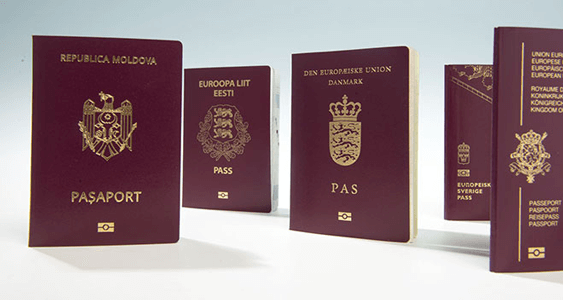
Gemalto contributes to over 30 national ePassport programs to date.
This achievement reflects the continued growth of identity markets and leadership of Sealys ePassport solutions from complete solutions or specific key components.
Gemalto's passport references includes in particular Algeria, Belgium, Côte d'ivoire, Colombia, Estonia, Denmark, France, Italy, Korea, Latvia, Lebanon, Malta, Moldova, Morocco, Norway, Oman, Peru, Portugal, Singapore, Sweden, Turkey and the United States of America.
Comprehensive approach to Passport Security
At Gemalto, we believe in taking a comprehensive approach to security. We offer extensive experience and support, enabling our customers to meet their expectations for distinctive documents that are as secure as they are attractive.
Collaboration with customers lies at the heart of our process and we have developed a comprehensive approach of passport security design that we believe can lead to superior results.
The future of ePassport
LDS2
The ICAO is currently working on the Logical Data Structure version 2 or LDS2, the next evolution of the ePassport standards.
LDS2 is still in its early stages as of 2016 and much work has still to be done by the ICAO NTWG Logical Data Structure 2 (LDS2) Sub-Group before it is applied.
Digital travel credentials
Ready to replace everything with a smart phone?
Smart virtual credentials are an important step that will certainly impact Machine Readable Passports in the future. We believe virtual passports can expand rapidly as a companion form of ID to physical passport.
Electronic Passport Trends:
The electronic passport in 2017
Migration to electronic passports has been in progress since 2005 and more than 120 states have started issuing this new type of travel document. Unlike conventional passports, the electronic passport has a microprocessor which stores a digital version of the ID photo as well as all of the ID data found on the first page of the paper passport.
In addition, digital fingerprints can be stored. In this case it is referred to as a biometric passport or second generation of electronic passport or e-passport.
Ten years after the launch of the first wave of electronic passports, we see 4 common trends in the approaches being adopted in electronic passport migration, the technologies selected, and the impacts on existing processes and the overall passport design.
Let's dig in.
4 common trends in ePassport migration
The recent ePassport programs set a pattern that should be considered when planning a migration to a new generation of electronic passport.
In this context, public authorities will:
First, plan a total document update.
Countries that have introduced new electronic passports over the past decade have taken the opportunity to totally update their national travel document.
They have added a range of additional visual and electronic security features to combat identity fraud and to strengthen national and international confidence in travel documents.
Second, re-engineer existing processes.
The introduction of a microprocessor-based passport has also been the catalyst for reengineering life cycle processes, from enrollment to issuance, and is now facilitating border control as automatic border control gates are being implemented in airports.
Third, count on the e-passport.
It is clear that the key components of new electronic passports involve technology and solutions which are robust and fully capable of delivering the results required.
Then, set new design expectations.
Last but not least, authorities have set new design expectations for distinctive passports that are as secure as they are attractive.
Many countries have been able to deliver unique travel documents that become works of art and symbols of trust and pride in the hands of millions. The Norwegian epassport in the making and to be launched in 2018 and the Finnish epassport launched in January 2017 are two vivid examples illustrating this trend.
Get the most valuable experience
Gemalto is currently contributing to more than 40 passport initiatives and border management programs.
Our contribution to these projects provides us with :
- an excellent overview of the technology involved,
- its applications,
- the quality of information systems,
- as well as the context of its use.
We are proud to have helped our customers succeed in designing some of the most secure and attractive passports to appear in recent years.
As a major player in the world of secure electronic passports, we believe Gemalto's mission is also to contribute to informing our partners and the wider industry, sharing best practices and presenting expert analysis. We'll be happy to talk with you about your e-passport migration project.
LDS2: the Next Generation of Machine Readable Passport
The International Civil Aviation Organization is currently working on the Logical Data Structure version 2 or LDS2, the next evolution of the ePassport standards. They were initially implemented in 2005 based on the ICAO doc 9303 defining the specifications of machine readable passports.
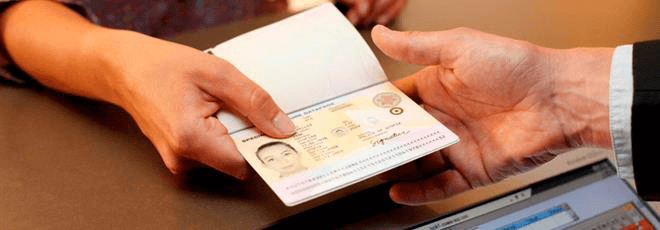
In particular, the ICAO defined the Logical Data Structure version 1 (LDS or LDS1), which is the way data is stored in the micro-controller in order to ensure international interoperability.
For the moment, information stored in the ePassport becomes static at the time of issuance and cannot be modified. In the field, the electronic passport micro-controller is "read-only".
"Sealing" the data at the time of issuance ensures that personal information is protected, and that passport tampering can be more easily detected.
Visas, travel stamps and biometrics impacted
Today, other travel data such as visas and travel stamps are physically entered into the document's visa pages and visa and travel records must be manually checked.
Recognizing this limitation, ICAO's New Technologies Working Group (NTWG) has commissioned a sub-group to explore the policy and technical framework for the next generation of machine readable passports.
While ICAO doc 9303 focused on the electronification of the passport datapage, the next generation specifications (Logical Data Structure v2 or LDS2) will focus on the digital conversion of the rest of the document.
LDS2, the new generation of the Logical Data Structure, will be optional and extend the use of the ePassport through the addition of a read-write function. Travel data such as visas and travel stamps, and other information such as additional biometrics could be added. In addition, LDS2 will further protect the document against counterfeiting, copying and unauthorized reading or writing.
Why does that matter?
Converting travel stamps to digital format will bring several benefits:
- Greater consistency
- More reliability
- Enhanced security
- Easier access.
LDS2 will allow electronic visas to be added to the document instantaneously, bolstering client service and reducing the costs associated with visa issuance.
Digitally signed storage of visa and travel stamps would dramatically increase the security of those elements against tampering while improving the security flow with Automatic Border Control gates. Standard formatting will also enhance the readability and reliability of the information and will facilitate the exchange of information between countries.
LDS2 will address the lack of a live biometric capture infrastructure across a country as well as privacy.
Citizens will be able to provide their biometric data on a voluntary basis if they want to enjoy the convenience of fast track through an eGate.
LDS2 will provide a more automated and reliable risk assessment with analysis of the risk that travellers present by detecting unusual travel patterns, disconnects between entry and exit stamps and mismatched travel history.
It will also enables automatic insertion and verification of data in the passport's micro-controller that will allow more people to go through electronic gates.
It will also build synergies with frequent and trusted travelers programs, eliminating the need for dedicated documents.

The best part?
The storage of biometrical data often takes place in several databases outside the direct control of the traveller. The alternative with LDS2 is to store those biometrics in the micro-controller for stronger privacy. The ePassport will act as an identification token.
At any time, data stored in the LDS2 application must be signed by the inspection or visa issuance system, allowing the verification of the authenticity of the data.
Right now, where do we stand?
LDS2 is still in its conception phase as of 2016 and much work has still to be done by the ICAO NTWG Logical Data Structure 2 (LDS2) Sub-Group before it is applied.
Virtual Passport:
Virtual passport: your passport in the cloud?
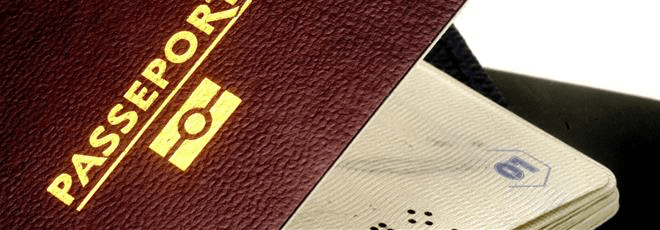
Virtual passport was initiated in 2015 in Australia out of a hackathon-style innovation event led by the Department of Foreign Affairs and Trade. It aims to see information from Australian passports stored in the cloud, alongside biometric identifiers, giving Australian citizens the opportunity for document-free travel between Australia and New Zealand.
With a virtual passport, a traveller's identity and biometrics data would be stored in a cloud, so passengers would no longer need to carry their passports and risk having them lost or stolen.
Digital Travel Credentials are rapidly becoming a hot topic worldwide, gaining support from the International Civil Aviation Organization (ICAO), the UN agency in charge of ePassport standardization.
In the meantime, Australia and New Zealand are considering a trial run of the digital passports.
Let's consider two examples to understand the power of such initiative and understand why cloud passports or more precisely Digital Travel Credentials can be ideal companions to physical documents.
You lose your passport while on travel.
Your consulate or Embassy could activate on your mobile phone a digital copy, retrieved from the Government Passport Agency's servers, so that you can cross borders.
Data in the mobile phone is signed using the same certificate than the data stored in the chip of the passport booklet that you lost, providing a much better level of security than most emergency travel documents (usually a piece of paper with some basic security features, and manual issuance in a Consulate).
You apply for a visa.
You must often visit a Consulate to apply for a visa, since you must give your passport for the visa to be issued in the visa pages of the booklet.
With Digital Travel Credentials, passport data could be transferred directly between the applicant's passport issuing authority and the visa office. This speeds up the process for both the visa office and the applicant, while allowing for higher level of confidence in the data provided.
With the next version of the ePassport specification (see on page on LDS2), it will even make it possible for the applicant to securely download the visa from the visa office in its passport, using a mobile phone, for faster check at point of entry in the country.
Such a use case can also be useful for pre travel authorization, since it increases the level of confidence in the data provided by the applicant.
That's not all.
In June 2016, the ICAO New Technologies Working Group has created a new sub-group on digital travel credentials. The ongoing work done on next generation ePassport, where visas and entry/exit stamps will optionally be stored in the micro-controller, has been transferred to this sub-group, given the natural convergence between the two topics.
Gemalto is actively involved in the standardization committees of ICAO and the International Organization for Standardization (ISO), which allows us to rapidly integrate all new protocols for the benefits of our customers.
We believe it is our mission to report and share trends and best practices from around the world.
Border & Visa:
Border agencies are being asked to cope with a rapid increase in traveler numbers and, within new security and cost constraints, to facilitate a swift and secure passenger experience. They are requested to boost legitimate trade and travel, prevent illegal immigration or identity fraud and tighten security measures at border crossings.
With the massive surge of electronic travel documents and national eID cards, Gemalto is supporting border agencies and government authorities to exploit technology convergence to gain consistent, comprehensive border, visa management and document verification that will:
- Deliver seamless travel with online visa applications
- Offer convenience for travelers for fast and secure border crossing
- Improve border intelligence for detection and prevention.
Coesys Border Management
Coesys Border Management provides a full range of applications to implement best-practice immigration processes and state-of-the-art technologies at border management headquarters (HQ) and border control points (BCPs).
Coesys Visa Management System
Coesys Visa Management is a full suite of service oriented applications designed to securely manage visa applications and issue visas, eVisas and resident permits.
Coesys Document Verification
Travel and identity document verification forms an integral part of sensitive processes like enrollment and registration, as well as in situations where certified identity is crucial - such as at border stations or during bank transactions.
Coesys Automated Border Control (ABC)
Coesys Automated Border Control (ABC) is an automated immigration control product that combines the latest technologies of electronic gate hardware and border control software.
Coesys Mobile Border and Visa Apps
Ease of use, convenience, massive costs savings using a full-fledged inspection system in officer’s pocket are only a few of the motivations that characterize the development of the Coesys Mobile Border and Visa Apps now deployed on smart phones, tablets and other mobile devices.
Coesys SPOC/n-PKD
Coesys SPOC/n-PKD simplifies inter-country certificate management for electronic passports.
Electronic Travel Authorization:
Ready to fly
Travelling is great, but depending on where you travel from and where you are planning to go, it can require quite some preparation. Besides finding the best deals for flights and hotels and carefully selecting your personal items to carry along, you may have to apply for a Visa before setting off.
Travel experience counts
If you need to apply for a visa before departure you will most likely have to go to the country's embassy or consulate or to a visa application center. It may also require mailing your passport to a consulate office. And you might be concerned about letting your passport out of your immediate possession as it is an important document for identification and there's always a risk of loss.
This can be quite a hassle for travelers, especially when the embassy or application center is far away!
More and more countries have put in place electronic visa (e-Visa or eVisa) or electronic travel authorization (eTA) and visa upon arrival to simplify the application process and increase security.
Before we move on, let's refresh our memories with a few definitions to make sure we know what we are talking about.
What is an eVisa?
eVisa: An electronic visa (e-Visa or eVisa) is an entry requirement performed online, stored in a computer and linked to the passport number used for the request. It simplifies the visa issuance process as there is no label, sticker or stamp to be placed in the passport before travel. The application is fully processed over the internet.
What is eTA meaning?
eTA: an electronic travel authorization or eTA is an entry requirement for visa-exempt foreign nationals travelling to or transiting to a country, usually by air. It allows the destination or transit country to screen travelers before they arrive, increasing visibility and security.
One of the most well-known eTA system is the ESTA on-line service for travelers who wish to travel to the United States under the Visa Waiver Program. These travelers have to apply for authorization.
what is a VOA?
Visa on Arrival: also known as VOA, it is granted at a port of entry, in most cases after an online pre-approval process. This is different from not requiring a visa at all, as the traveler must still obtain the visa through immigration before he can enter the destination country.
For VOA countries, there is usually an expedited process for visa applicants who have been accepted or pre-accepted through an online process. Travelers can benefit from special lines set up for those with an electronic visa to get through the immigration procedure more swiftly. This process can save a considerable amount of time, perhaps even hours.
In our recent dossier on eVisa portal we explain the benefits of pre-travel authorization in term of convenience and risk management. We also detail the three major factors behind the success of an eVisa project.
How to apply for an Electronic Travel Authorization (eTA)
Applying for an eTA is an easy online process.
Applicants will need a valid passport, a credit card and an email and can get their eTA approval via an email.
The application is then stored and linked to the applicant's passport number. All visa records are stored in a database which enables online checking of visa details by visa holders, registered country's organizations and airline staff.
There is no need to physically present yourself or your travel document and receive a visa sticker. The application is fully performed over the internet in just a few clicks and provides an advance permission to visit the country.

New biometric on-line verification process from Gemalto
In order to verify the applicant's identity online, Gemalto proposes an online ID Verification system that automatically verifies electronic and physical security features of identity documents.
This ID verification software combined with biometric identification allows to ensure that the document bearer is the rightful owner and is entitled to apply for a visa.
The process is described in the video above.
A proven framework with Gemalto's Visa Management
Did you know that world's largest outsourcing and technology services specialist for governments and diplomatic missions worldwide is using over ten Visa Management systems to serve over 1,000 visa application centers located in over 100 countries across five continents.
Evisa Portal:
eVisa portal and visa management system
Online visa application is now an essential component of a modern, integrated visa management system. It is key to enhancing both security and convenience.
As a result, a new generation of eVisa solutions has emerged, moving the entire visa application and issuance process online through an eVisa portal. Benefits include an enhanced traveler experience and significant reductions in administration costs, without compromising border integrity.
By combining experience and a strict management of the business rules needed to adapt to diverse processes, it is possible to implement a complex eVisa management system in just three to four months.
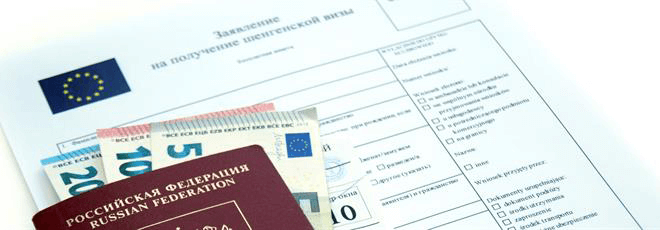
In this article, we'll discuss:
-
- the key features of an eVisa system,
- the advantages it offers over traditional processes,
- the potential impact on homeland security.
- the three major factors behind the success of an eVisa project.

The traditional process can take anywhere from a week to two months. It can also prove costly and stressful.
That's a REALLY bad start to the traveler experience.
Fortunately, there's a simple way around these frustrating issues….
How does an electronic visa work?
Quite simply, it allows the management of the visa application process to take place entirely online through an eVisa portal.
It's no surprise that this kind of online services are appreciated by travelers. Online eVisa services hide away obscure processes that are being done in different offices. When travelers are given the opportunity to get away from this red tape, they do not hesitate!
Everything is done via the Internet:
- The visa application
- The payment
- The decision on the application.
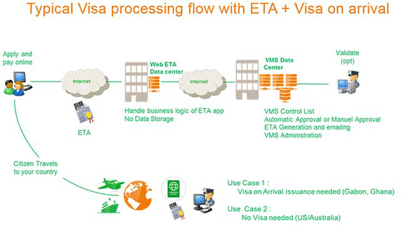
An eVisa system manages the whole lifecycle of the visa request until final approval.
The system administrators can supervise the status of the request and see whether it is pending or validated. They can check the documents and data provided by the citizen, verify the result of the matching against national or Interpol databases, right up to the final administrative acceptance of the visa.
Online visa application: 3 benefits
Let's take a closer look at the benefits of setting up an online eVisa system.
Cost savings
Because the whole process is online, logistics are simplified and streamlined.
No more face-to-face appointments at a visa office, where a government employee manually inputs data onto the system and scans documents provided by the applicant.
In addition, once approval is granted, such a system eliminates the need to print a visa sticker and return the document to the holder.
According to the World Bank over a period of six months in 2014 Moldovan embassies saved between 12 and 14% of working time as a direct result of the introduction of eVisas.
Providers also stand to make significant financial savings by doing away with visa stickers. For example, in 2013 alone, European countries issued more than 16 million short-term visas, at a total cost of 10 million Euros.
Time saving
For applicants and government authorities alike, time and money are wasted on clumsy and frustrating paper-based systems. A traveler applying for a visa has to fill out the necessary paperwork and then either send it back by mail or physically take it to the destination state's local embassy or consulate. The embassy or consulate will then process the request, review the documents provided and send the approved visa back to the applicant.
With eVisa, requests are submitted via a secure application portal which can be accessed 24/7.

Revenue boosting
Get more fees, more visits and more jobs. Legislation usually enables the collection of additional processing fees for eVisas. This can be up to 20% more than the charge for a traditional one, covering the costs of operating and maintaining the portal and management system.
In addition, the introduction of a more convenient visa application process can stimulate both tourist and business travel.
The World Travel and Tourism Council, in its 2012 report The Impact of Visa Facilitation on Job Creation in the G20 Economies, highlighted a potential increase of over 15% in overseas tourist arrivals as a result of visa facilitation programs, generating a rise of up to 20% in traveler spend in the destination country.
The 2015 European Travel Commission's study titled Improving the Visa Regimes of European Nations to Grow Tourism puts it very clearly:
"The harder it is for potential tourists to secure a visa, the greater the share of global tourism that Europe will lose. The easier it is for tourists to access European destinations, the greater the economic benefit and job creation that flows to our economies."
The impact of eVisa on border security and immigration control
Unprecedented threats to homeland security and the growth of large scale migration are just two of the factors driving the need for rigorous border controls.
As a result, you cannot improve the speed and efficiency of visa processing at the expense of security.
eVisa solutions can encompass a number of measures that address governments' need to maintain and boost security:
- Enhanced control and tracking: electronic systems provide authorities with real-time visibility of trends in demand for visas and the profile of applicants. They also enable on-demand information on the status of specific visa requests.
- Strengthened security: eVisa systems can integrate automatic, real-time background checks and links to watch-lists.
- Upfront document verification: in most cases, a traveler's biometrics are checked against the document and/or registered information at the border control point. But with eVisa systems, the ID document can be verified beforehand as part of the on-line visa request process. Biometric checks can also be included, using a webcam.
- Payment card-based identity verification: with eVisas, it is possible to protect against the threat of applicants using a stolen identity during the online request process. Applicants can be asked to pay the visa fee using a debit or credit card issued in their own name. Information on the card submitted for payment can be compared automatically with the information and document submitted with the online visa portal.
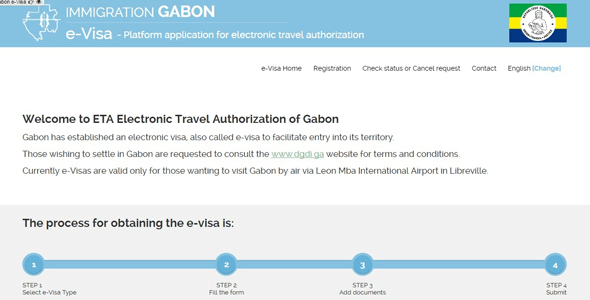
Regular travelers to Gabon have welcomed the government's decision to launch its eVisa portal, moving away from procedures sometimes viewed as complicated.
Where collection of biometric data online is a concern - such as fingerprints - the eVisa service can be offered initially to low risk categories of traveler. Typically these might include applicants whose biometric data has been collected previously.
Another alternative is to keep the online application process open to all, and deliver an Electronic Travel Authorization (eTA) to travelers whose biometric data has yet to be collected.
These travelers then receive their visa on arrival at the destination airport, where fingerprints can be collected by immigration officers. At a later stage, authorities can decide whether to extend the use of eVisas, based on lessons learned.
3 key factors when introducing online visa application
Putting in place an eVisa system goes way beyond the setting up of a web portal accessible to users to start their visa request.
Request processes are not standard and vary from one country to another.
1. Your system's ability to adapt to different approval cycles.
eVisa approval cycles differ from one country to another. Some countries have two levels of approval, others can have up to four. The visa types and request conditions can also vary from one country to another. You can find single or multiple entry visas, for different durations.
2. Your ability to support different types of authorizations.
The electronic visa system must support different types of authorizations such as work permit, resident permit, student visa and more.
3. Your ability to integrate third parties.
The system should also adapt to situations where the application is done by a third party and not the traveler. Indeed, in many cases the visa request is done by an agent or a certified company.
A proven framework from Gemalto: Coesys Visa Management
Did you know that world's largest outsourcing and technology services specialist for governments and diplomatic missions worldwide is using over ten Coesys Visa Management engines to serve over 1,000 visa application centers located in over 100 countries across five continents?
Driving License:
Identification and accountability for better road safety
The driver's license is a document with multiple uses.
On the road, it gives its holder the right to drive certain vehicles.
Very often, it also serves as an identity document, particularly in countries which do not have a national identity card program. This is just one more reason why it has to be highly secure.
States have more recently developed the international ISO/IEC 18013 standard, which came into force in 2009 and outlines the framework for migration towards a secure, credit card-format document.
The standard stipulates the use of visual security elements comparable to those used on identity cards and passports. It also lays down a standardized structure for the basic data set (IS0 1813-1).
The material adopted by Europe is polycarbonate, a durable medium, which is hard to counterfeit.
This solution is also more and more selected in North America and around the world.
What makes polycarbonate so exceptional?
What sets it apart from other materials is also its non-delaminable property..
When laminated under heat and pressure without adhesives, and not mixed with other plastics, the the intertwined layers of polycarbonate make it virtually impossible to swap document information or photos without completely destroying the document.
It's the same material used to make bulletproof glass and you can you can hear the difference: polycarbonate driver's licenses are so rigid they sound like a compact disc when dropped.
A wide range of cards, solutions and services
Gemalto offers a wide range of cards, from secure chipless cards to a high security cards with contact and contactless interfaces, as well as comprehensive solutions for driver management and registration, the issuance and checking of documents, in addition to managed services for the issuing of licenses on behalf of Governments, as in Norway.
With its expertise in polycarbonate and innovative security features, Gemalto is proud to contribute to the new Greek, Norwegian and UK driver's license initiatives.
Several countries have already opted for the credit card format and smart card for their driving license programs by selecting Gemalto as their partner.
India, Australia,El Salvador and Mexico are just some of Gemalto's customers in this area.
Enhanced Drivers Licenses
Enhanced Drivers Licenses or EDLs are driving licenses and identity cards with an embedded RFID chip issued by some US states and Canadian provinces to facilitate and speed up entering the United States by land and sea from neighboring countries. They provide proof of identity and citizenship and are issued after a secure registration process.
Border inspection booths equipped with contactless terminals can read the unique identifying number of an EDL over a distance of up to 10 meters. Officers can easily perform a background verification of the card holder approaching the check point even before being shown the physical card for a visual inspections.
Marquis ID Systems (MIDS), a Gemalto Company based in Fort Wayne (Indiana) has developed solutions for enhanced drivers licenses from secure enrollment to issuance and document verification for Departments of Motor Vehicles.
Digital Driver's License
Today, many government agencies in charge of vehicle registration and driver licensing are investigating a smartphone version of their driver's license. These digital driver's license or mobile driver's license could bring more convenience to citizens and bring new opportunities for transactions that require some form of identification.
Standards are far from being defined. However, digital driver's licenses can expand rapidly as a companion form of ID to physical driver's licenses.
Gemalto Mobile DL solutions bring technology and implementation models which take into account user-friendliness, the local driver's license schemes and practices (drivers, Police, service providers…), and offer the highest level of security in both credential storage, data transmission and verification.
In North America, Marquis ID Systems (MIDS), a Gemalto Company, has developed solutions from secure enrollment to issuance and document verification for Departments of Motor Vehicles and is presently working with eleven states. Marquis IS Systems solution for Mobile driver's license is a highly secure way to deliver, store and manage the lifecycle of a driver's license on a smartphone.
Digital Tachograph
The digital tachograph in Europe is a technical achievement for enhanced road safety in Europe. Learn more about the project and its benefits.
Sealys Tachograph is a complete product offering, designed to meet all the requirements set by EU tachograph regulations. Learn more about our solution.
For more than ten years, Gemalto has contributed to nu merous tachograph card projects that now extend to 34 different countries. The acquisition of Trüb in 2015 brought together the two leading companies offering tachograph card solutions. This long and broad experience ensures smooth running of new tachograph projects and the efficient achievement of mandatory certifications and type approvals.
Electronic Vehicle Registration Cards (eVRC)
There is growing interest in the introduction of a highly secure electronic registration document to fight fraud, gain savings by dematerializing processes and bring convenience to government administration, private businesses and citizens with effective e-Services.
Gemalto Electronic Vehicle Registration cards offer a flexible approach for electronic vehicle registration card and its related use cases from modules to turn-key projects.
We can offer:
- Versatile IAS electronic application for secure vehicle data storage and eServices with secure polycarbonate or PET/PVC cards
- Flexible end-to-end solution: enrolment, issuance, verification, eGovernment infrastructure
- Managed issuance services to leverage the power of outsourcing
With Gemalto Electronic Vehicle Registration cards, you can:
- provide ultimate document security and effectively prevent attempts to modify or change data
- allow secure identification of the owner
- facilitate efficient road side checks
- track the entire life cycle of new and second-hand cars
- enable smarter management for taxes, insurances and fines
El Salvador introduced eVehicle registration card in 1998 to streamline and centralize administrative processes as well as to tighten up security in order to fight vehicle theft, illegal importation, identity theft, and to reduce fraud related to counterfeit documents. The smart card solution helped to fully automate procedures and processes for government management of vehicle registration, licensing and tax and fine payments. It also enhanced safety for the general public. Furthermore, it improved the Tax Administration’s ability to collect fees compared to the previous procedures. In the first year of the new service, tax evasion was reduced with a 35 percent annual increase of taxes paid compared to the previous year. The higher rate of collection in the vehicle circulation tax was due to a greater control and ease of payment procedures.
India implemented an infrastructure that now offers immediate access to information about drivers and their vehicles to police and other authorities. The latest development has been a common layout for eVRC with standard security features for all states (cross-border verification).
In addition to road safety prevention measures that will leverage applications such as "Point-record driving license" and vehicle control history, Moroccan Ministry of Transport aims to use e-driver's license and vehicle registration cards to provide citizens with a set of services that touch multiple facets of their daily lives.
Morocco’s eDL and eVRC could gather future applications for public transportation, motorways tolls, insurance and tax payments, etc.
Digital Driving License:
The world is evolving rapidly towards mobile and digital formats for many everyday tasks.
Key drivers for this trend are convenience and ease of use for transactions that require some form of identification. And one of the most used documents to confirm identity is looking at going down this route - the driver's license.
The primary goals of the driving license, whether physical or digital, remain to confirm identity and to confer the right to drive a vehicle.
During the course of 2015 and 2016, studies and pilots have been launched in several states in the US to explore the technical feasibility of a digital driver's license.
There, digital driver's licenses also named mobile driver's licenses are set to retain the key visual aspects of a physical driver's license, displaying the driver's personal information - name, address and date of birth, along with his photo.
Various technologies are considered to address but security and user friendliness will be key drivers.
There's more.
The topic is now receiving even more federal attention.
In August 2016, the U.S. Commerce Department's National Institute of Standards and Technology (NIST) awarded a grant to further support the development of trusted identities based on Digital Driver's License provided by states.
Through a $2M grant awarded to Gemalto, four jurisdictions – Idaho, Colorado, Maryland and Washington D.C. – will soon be implementing a pilot for a secure Digital Driver's License (DDL), which many believe to be the future of trusted identities.
There are striking similarities in challenges and potential benefits with what is called a "national eID scheme" in many other countries where states are including digital identity as a defining feature in a digital space of trust, with good levels of security, interoperability and data protection.
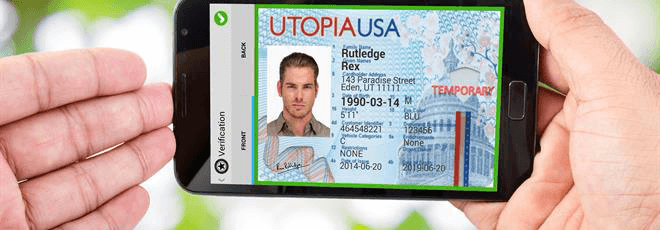
Convenience of the mobile format – potential new identification use cases
Beyond the important security aspects, issuing authorities have shown particular interest in the universal convenience of this mobile format:
- Convenience for holders, who can travel lighter with a digital driver's license, instantly updatable, on their phone.
- Convenience for law enforcement or other parties wanting to verify identity and privileges.
- Convenience for issuing authorities who can explore new services needing such a trusted and secure channel for sharing and validating identity.
The driver's license has been a standard for decades, acting not just as proof that you can drive but as an ID to verify age and identity, opening mobile driver's license to many usages such as:
- Police control: roadside stops to identify the driver of a vehicle and his/her privileges.
- Proof of age: where purchase of alcohol, as in many countries, is restricted to people aged 18 or more, verified by the retailer.
- Car rental: to identify the renter, ensure driving privileges and share attributes (address…etc )
- Identity validation or confirmation for hotel check-in, financial institutions, social services...
- Online authentication: from access control to identity verification…
Digital driver's license - The 2016 US landscape
Iowa was the first state decide to test digital driver's license in 2014. It started a pilot on an IOS platform with 100 state employees at the end of 2015. The goal was to test the daily usability of the solution. The Department of Transportation hopes to make the app public in 2017.
Several legislatures (legislative body of States in the United States) authorize the study of smartphone driver's license such as Arizona, Illinois, Utah and Texas to name a few.
Some other states have legislation under consideration. Idaho, Colorado, Maryland and Washington D.C are now on their way to set up a pilot funded by a federal grant.
- In Tennessee, legislation (HB556) enacted in May 20, 2015 authorizes the State DMV to develop a secure "electronic driver license system" and to display electronic images on a cellular phone or any other portable electronic device.
- In Arizona the Senate Bill 1237 bill was passed and signed on May 11, 2016. The Arizona Department of Transportation (ADOT) has to study and specify what may be done with an electronic driver license.
- In Utah, Bill 227 effective in May 2016 requires the Driver License Division and Department of Technology Services to study and report findings and recommendations regarding electronic driver licenses.
- In Louisiana, Bill 481 was signed by Governor Edwards on June 23, 2016. The law outlines requirements for a digitized driver's license. It allows persons to use the digitized license in lieu of a physical license when stopped by law enforcement. The proposed law provides that display of the digital driver's license shall not serve as consent to search the mobile device. A fee of up to $6 can be charged for use of the electronic credential application.
- Kentucky was considering the topic as well but the feasibly study has not been launched as the measure did not receive a hearing.
- In California, the state legislature passed a bill (February – September 2015) to study the feasibility of a digital mobile driver's license app for smart phone. It was however vetoed by Governor of California Jerry Brown in October 2015.
- In New Jersey, the bill introduced in January 2016 has been withdrawn from consideration in February 2016.
- In Illinois, the Legislature approved a resolution in 2015 that created an Electronic Driver's License Task Force to study the feasibility of a digital/mobile DL. The Task Force reported its finding on April 21, 2016. It recommended that the Secretary of State continue to monitor advancements in mobile driver's license technology.
- In March 2015, North Dakota passed HCR 3036, a bill to study implications of driver's licenses for smart phones. However, the measure has not been considered as of October 2016 by Legislative Management.
- In August 2016, through a $2M grant awarded to Gemalto, Idaho, Colorado, Maryland and Washington D.C. are to set a pilot for a secure Digital Driver's License (DDL). Its goals are to define and create a convenient and secure way for citizens and authenticating parties to exchange and verify government-issued credential information via smartphone.
The American Association of Motor Vehicle Administrators Working Group is looking at DDL standards and their specifications.
The legal environment is also positively impacted by the famous Riley v. California case of September 2014. The United States Supreme Court ruled that Police may not, without a warrant, search digital information on a mobile phone seized from an individual during an arrest.
This makes it easier for states to implement DDL solutions since the court is clear: police cannot arbitrarily search phones.
Other initiatives around the world
- In Australia, New South Wales announced in November 2015 the introduction for 2016 of digital driving licenses on smartphones and in February 2016 the press revealed that Victoria is also analyzing technology to produce digital driver's licenses in the next few months. Western Australia State announced a plan to turn driver's licenses into digital IDs in April 2016.
New South Wales' Premier Mike Baird promised to introduce the digital license within four years. However a lot of co-operation will be needed to set up a working multi-jurisdictional approach in the country. - In May 2016, Britain's Driver and Vehicle Licensing Agency (DVLA) revealed it is also working on a digital driving licence for smart phones and showed a "prototype" of a feature that would let people store their license in their phone and turn driver's iPhone into an ID.
- In October 2016, senior officials at the Dutch road transport authority have made it clear that the country is working on a mobile app version of the license that would accompany a card.
Other countries like India are investigating this option. As of today, the market is at a very early stage and standards are not fully defined.

4 key requirements
Mobile driver's license needs to address 4 key requirements in order to gain acceptance as a trusted digital identity.
It needs to be:
- accessible in both online and offline modes,
- highly secure to protect the confidentiality and privacy of user data,
- interoperable between different issuing and verifying authorities,
- able to manage the integrity of data throughout its life cycle - from enrolment to the in-field verification process.
For the time being, mobile driving licenses will not replace physical driver's licenses but will exist as a secondary form of ID to complement to these physical driver's licenses.
Technologies and implementation models from Gemalto
In September 2015, Gemalto conducted an extensive study with a consumer on-line community gathering 200 members from the United Kingdom and United States. The direct feedback from potential users of the digital driver's license solution revealed the benefits, concerns and the diversity of audiences. These results allowed the company to set up relevant implementation models.
Gemalto Mobile DL solutions bring technology and implementation models which take into account user-friendliness, the local DL schemes and practices (drivers, Police, service providers…), and provide the highest level of security in both credential storage, data transmission and verification.
What's the story here?
Not only does a digital credential bring new layers of security, such as PIN or fingerprint verification, but it is also much more difficult to fraudulently duplicate or alter.
Why?
Because it is checked with the issuer backend in real-time, a fraudulent credential can quickly and easily be identified as invalid, to make verifying even out-of-state digital credentials significantly simpler and more secure.
If a user's mobile device is ever lost or stolen, the digital license can be remotely deactivated or wiped almost instantly.
Unlike a traditional driver's license card, a mobile driver's license never needs to leave the owner's hands. A person verifying the driving license in the field will have access to advanced real-time authentication through another version of the application on an authentication device – either another smart-phone or a reader.
No footprint is left on the verification device and no geo-location tagging or tracking of user information occurs.
With a digital driver's license, an issuer can have much greater control over in-use credentials compared to a traditional physical license - for example alerting holders when their license is about to expire. Citizens could also update their personal information or even renew their license directly through the application instead of visiting a branch office, saving time and resources.
Control and convenience will prove essential elements for issuers and users on the road to mobile driver's licenses.
This form of digital credential could enable a new, more efficient and more secure way of authenticating a person and their entitlement for a range of personal identification usages.
More about Gemalto
In the public sector, Gemalto provides secure documents, robust identity solutions and services for governments, national printers and integrators in the service of citizens. Its products and solutions are deployed in more than 100 government programs worldwide.
The company is active in numerous driving license and vehicle registration projects including the UK, the Netherlands, France, India, Mexico, Morocco, States of Alaska, Maryland, New Hampshire, West Virginia, Idaho, Colorado, District of Columbia, Hawaii, West Virginia, Wyoming, Quebec to name a few.
Our contribution to these projects provides us with an excellent overview of the technology involved, its applications and the quality of information systems, as well as the context of its use. Furthermore, our experts have provided support for national debates on how to improve systems, in particular to fight fraud. Finally, Gemalto is an active collaborator in European and global standardization.
Digital Tachograph:
Solutions for your digital tachograph card and more

Adapt to the new tachograph regulations
For more than ten years, Gemalto has contributed to numerous tachograph projects that now extend to 34 different countries. The acquisition of Trüb in 2015 brought together the two leading companies offering tachograph card solutions.
This long and broad experience ensures smooth running of new tachograph projects and the efficient achievement of mandatory certifications and type approvals.
Sealys Tachograph is a complete product offering, designed to meet all the new requirements set by EU tachograph regulations.
Depending on the customer's individual needs, Sealys Tachograph is available either :
- as microcontroller modules on reel,
- as raw tachograph smartcards in any of the four application profiles,
- or personalized cards with holders' individual personal information.
The Sealys contact-based tachograph can withstand intensive usage and harsh environmental conditions such as pronounced temperature changes or strong vibrations.
Most durabe and secure cards
Customers can count on Sealys Premium PC, Gemalto smartcards manufactured from most durable and secure polycarbonate with laser personalization, for an exceptionally high level of reliability and security.
There is a very simple fact to prove this.
Reports by MEBA, the international association of the tachograph card issuing authorities, show that return rates of Gemalto tachograph cards are much lower than the average for all smartcards in the field (well below 1% for Gemalto vs. around 4% overall).
Take advantage of our experienced service teams
Gemalto also has the capabilities necessary to deliver turnkey solutions, thanks to specialized integration services and its flexible Coesys system offering. As a result, resources are saved and lead-times shortened for the introduction of tachograph cards in the field.
Alternatively, for customers seeking hassle-free issuance without the need to invest in any systems or processes, Gemalto offers Allynis managed services, where personalized tachograph cards are directly delivered to end-users within an agreed timeframe.
Pricing Notes:
- Pricing and product availability subject to change without notice.

